室外花岗岩泛碱原因和处理办法
- 格式:doc
- 大小:38.00 KB
- 文档页数:5
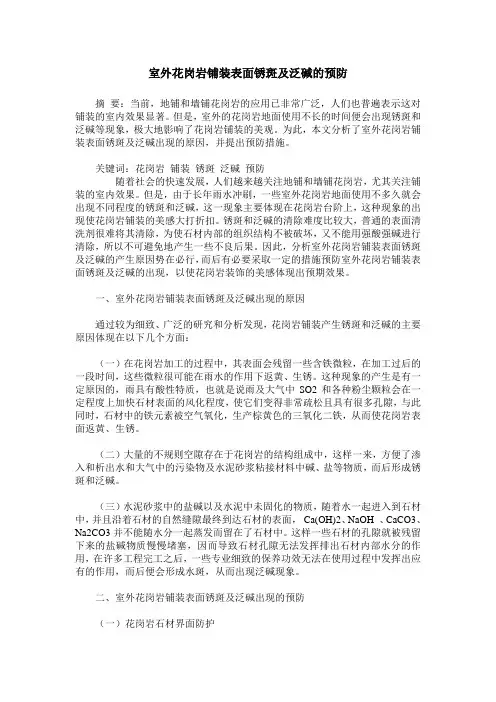
室外花岗岩铺装表面锈斑及泛碱的预防摘要:当前,地铺和墙铺花岗岩的应用已非常广泛,人们也普遍表示这对铺装的室内效果显著。
但是,室外的花岗岩地面使用不长的时间便会出现锈斑和泛碱等现象,极大地影响了花岗岩铺装的美观。
为此,本文分析了室外花岗岩铺装表面锈斑及泛碱出现的原因,并提出预防措施。
关键词:花岗岩铺装锈斑泛碱预防随着社会的快速发展,人们越来越关注地铺和墙铺花岗岩,尤其关注铺装的室内效果。
但是,由于长年雨水冲刷,一些室外花岗岩地面使用不多久就会出现不同程度的锈斑和泛碱,这一现象主要体现在花岗岩台阶上,这种现象的出现使花岗岩铺装的美感大打折扣。
锈斑和泛碱的清除难度比较大,普通的表面清洗剂很难将其清除,为使石材内部的组织结构不被破坏,又不能用强酸强碱进行清除,所以不可避免地产生一些不良后果。
因此,分析室外花岗岩铺装表面锈斑及泛碱的产生原因势在必行,而后有必要采取一定的措施预防室外花岗岩铺装表面锈斑及泛碱的出现,以使花岗岩装饰的美感体现出预期效果。
一、室外花岗岩铺装表面锈斑及泛碱出现的原因通过较为细致、广泛的研究和分析发现,花岗岩铺装产生锈斑和泛碱的主要原因体现在以下几个方面:(一)在花岗岩加工的过程中,其表面会残留一些含铁微粒,在加工过后的一段时间,这些微粒很可能在雨水的作用下返黄、生锈。
这种现象的产生是有一定原因的,雨具有酸性特质,也就是说雨及大气中SO2和各种粉尘颗粒会在一定程度上加快石材表面的风化程度,使它们变得非常疏松且具有很多孔隙,与此同时,石材中的铁元素被空气氧化,生产棕黄色的三氧化二铁,从而使花岗岩表面返黄、生锈。
(二)大量的不规则空隙存在于花岗岩的结构组成中,这样一来,方便了渗入和析出水和大气中的污染物及水泥砂浆粘接材料中碱、盐等物质,而后形成锈斑和泛碱。
(三)水泥砂浆中的盐碱以及水泥中未固化的物质,随着水一起进入到石材中,并且沿着石材的自然缝隙最终到达石材的表面,Ca(OH)2、NaOH 、CaCO3、Na2CO3并不能随水分一起蒸发而留在了石材中。
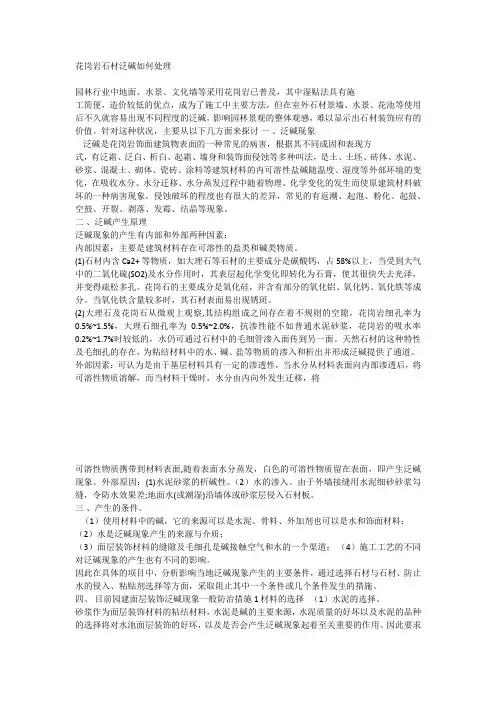
花岗岩石材泛碱如何处理园林行业中地面、水景、文化墙等采用花岗岩已普及,其中湿贴法具有施工简便,造价较低的优点,成为了施工中主要方法,但在室外石材景墙、水景、花池等使用后不久就容易出现不同程度的泛碱,影响园林景观的整体观感,难以显示出石材装饰应有的价值。
针对这种状况,主要从以下几方面来探讨一、泛碱现象泛碱是花岗岩饰面建筑物表面的一种常见的病害,根据其不同成因和表现方式,有泛霜、泛白、析白、起霜、墙身和装饰面侵蚀等多种叫法,是土、土坯、砖体、水泥、砂浆、混凝土、砌体、瓷砖、涂料等建筑材料的内可溶性盐碱随温度、湿度等外部环境的变化,在吸收水分、水分迁移、水分蒸发过程中随着物理、化学变化的发生而使原建筑材料破坏的一种病害现象,侵蚀破坏的程度也有很大的差异,常见的有返潮、起泡、粉化、起鼓、空鼓、开裂、剥落、发霉、结晶等现象。
二、泛碱产生原理泛碱现象的产生有内部和外部两种因素:内部因素:主要是建筑材料存在可溶性的盐类和碱类物质。
(1)石材内含Ca2+ 等物质,如大理石等石材的主要成分是碳酸钙,占58%以上,当受到大气中的二氧化硫(SO2)及水分作用时,其表层起化学变化即转化为石膏,使其很快失去光泽,并变得疏松多孔。
花岗石的主要成分是氧化硅,并含有部分的氧化铝、氧化钙、氧化铁等成分。
当氧化铁含量较多时,其石材表面易出现锈斑。
(2)大理石及花岗石从微观上观察,其结构组成之间存在着不规则的空隙,花岗岩细孔率为0.5%~1.5%,大理石细孔率为0.5%~2.0%,抗渗性能不如普通水泥砂浆,花岗岩的吸水率0.2%~1.7%时较低的,水仍可通过石材中的毛细管渗入面传到另一面。
天然石材的这种特性及毛细孔的存在,为粘结材料中的水、碱、盐等物质的渗入和析出并形成泛碱提供了通道。
外部因素:可认为是由于基层材料具有一定的渗透性,当水分从材料表面向内部渗透后,将可溶性物质溶解,而当材料干燥时,水分由内向外发生迁移,将可溶性物质携带到材料表面,随着表面水分蒸发,白色的可溶性物质留在表面,即产生泛碱现象。
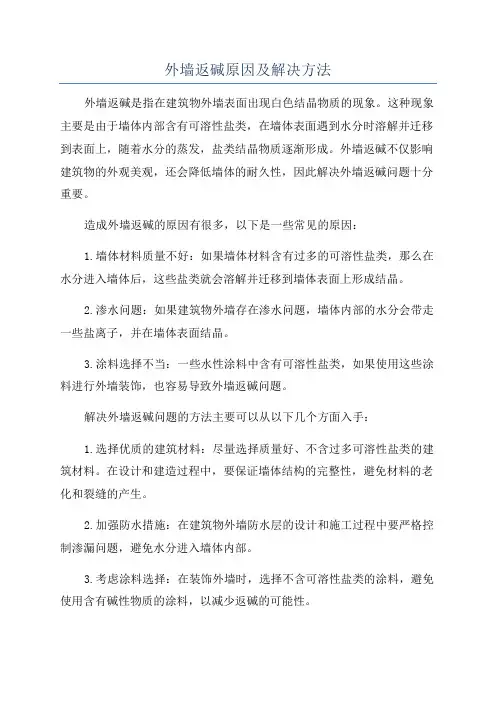
外墙返碱原因及解决方法外墙返碱是指在建筑物外墙表面出现白色结晶物质的现象。
这种现象主要是由于墙体内部含有可溶性盐类,在墙体表面遇到水分时溶解并迁移到表面上,随着水分的蒸发,盐类结晶物质逐渐形成。
外墙返碱不仅影响建筑物的外观美观,还会降低墙体的耐久性,因此解决外墙返碱问题十分重要。
造成外墙返碱的原因有很多,以下是一些常见的原因:1.墙体材料质量不好:如果墙体材料含有过多的可溶性盐类,那么在水分进入墙体后,这些盐类就会溶解并迁移到墙体表面上形成结晶。
2.渗水问题:如果建筑物外墙存在渗水问题,墙体内部的水分会带走一些盐离子,并在墙体表面结晶。
3.涂料选择不当:一些水性涂料中含有可溶性盐类,如果使用这些涂料进行外墙装饰,也容易导致外墙返碱问题。
解决外墙返碱问题的方法主要可以从以下几个方面入手:1.选择优质的建筑材料:尽量选择质量好、不含过多可溶性盐类的建筑材料。
在设计和建造过程中,要保证墙体结构的完整性,避免材料的老化和裂缝的产生。
2.加强防水措施:在建筑物外墙防水层的设计和施工过程中要严格控制渗漏问题,避免水分进入墙体内部。
3.考虑涂料选择:在装饰外墙时,选择不含可溶性盐类的涂料,避免使用含有碱性物质的涂料,以减少返碱的可能性。
4.适时维修和养护:如果外墙出现了返碱问题,需要及时进行维修和养护。
首先需要清除墙体表面的盐结晶物质,可以使用水冲洗或刷洗的方法。
然后选择适当的修补材料进行修复,例如使用防潮、防碱性能好的防水涂料进行涂装。
5.加强外墙保温:外墙保温可以有效地减少外墙返碱的产生。
保温材料可以起到隔热和防潮的作用,减少墙体与外部环境的接触,降低返碱的概率。
6.加强监测和维护:定期对建筑物的外墙进行检查,及时发现返碱问题,加强维护措施,避免问题的进一步恶化。
总之,外墙返碱是建筑物外墙中常见的问题之一,需要重视并及时解决。
通过选择良好的建筑材料、加强防水措施、合理选择涂料、适时维修和养护,以及加强外墙保温和监测,可以有效地降低外墙返碱问题的发生,并提高建筑物的耐久性。
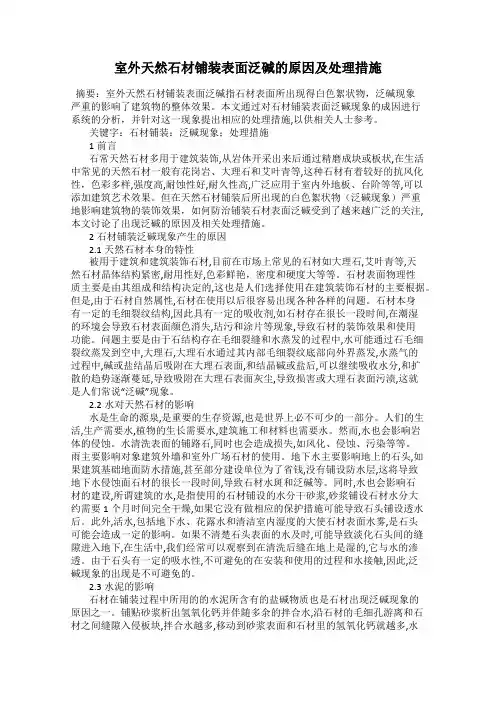
室外天然石材铺装表面泛碱的原因及处理措施摘要:室外天然石材铺装表面泛碱指石材表面所出现得白色絮状物,泛碱现象严重的影响了建筑物的整体效果。
本文通过对石材铺装表面泛碱现象的成因进行系统的分析,并针对这一现象提出相应的处理措施,以供相关人士参考。
关键字:石材铺装:泛碱现象;处理措施1前言石常天然石材多用于建筑装饰,从岩体开采出来后通过精磨成块或板状,在生活中常见的天然石材一般有花岗岩、大理石和艾叶青等,这种石材有着较好的抗风化性,色彩多样,强度高,耐蚀性好,耐久性高,广泛应用于室内外地板、台阶等等,可以添加建筑艺术效果。
但在天然石材铺装后所出现的白色絮状物(泛碱现象)严重地影响建筑物的装饰效果,如何防治铺装石材表面泛碱受到了越来越广泛的关注,本文讨论了出现泛碱的原因及相关处理措施。
2石材铺装泛碱现象产生的原因2.1天然石材本身的特性被用于建筑和建筑装饰石材,目前在市场上常见的石材如大理石,艾叶青等,天然石材晶体结构紧密,耐用性好,色彩鲜艳,密度和硬度大等等。
石材表面物理性质主要是由其组成和结构决定的,这也是人们选择使用在建筑装饰石材的主要根据。
但是,由于石材自然属性,石材在使用以后很容易出现各种各样的问题。
石材本身有一定的毛细裂纹结构,因此具有一定的吸收剂,如石材存在很长一段时间,在潮湿的环境会导致石材表面颜色消失,玷污和涂片等现象,导致石材的装饰效果和使用功能。
问题主要是由于石结构存在毛细裂缝和水蒸发的过程中,水可能通过石毛细裂纹蒸发到空中,大理石,大理石水通过其内部毛细裂纹底部向外界蒸发,水蒸气的过程中,碱或盐结晶后吸附在大理石表面,和结晶碱或盐后,可以继续吸收水分,和扩散的趋势逐渐蔓延,导致吸附在大理石表面灰尘,导致损害或大理石表面污渍,这就是人们常说“泛碱”现象。
2.2水对天然石材的影响水是生命的源泉,是重要的生存资源,也是世界上必不可少的一部分。
人们的生活,生产需要水,植物的生长需要水,建筑施工和材料也需要水。
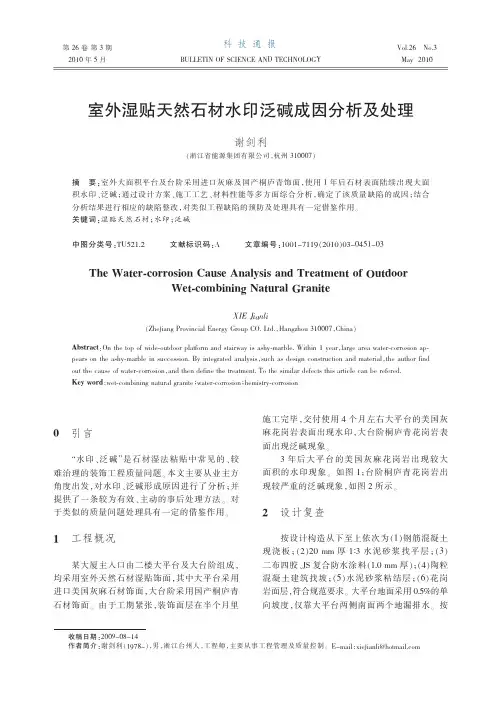
0引言“水印、泛碱”是石材湿法粘贴中常见的、较难治理的装饰工程质量问题。
本文主要从业主方角度出发,对水印、泛碱形成原因进行了分析;并提供了一条较为有效、主动的事后处理方法。
对于类似的质量问题处理具有一定的借鉴作用。
1工程概况某大厦主入口由二楼大平台及大台阶组成,均采用室外天然石材湿贴饰面,其中大平台采用进口美国灰麻石材饰面,大台阶采用国产桐庐青石材饰面。
由于工期紧张,装饰面层在半个月里施工完毕,交付使用4个月左右大平台的美国灰麻花岗岩表面出现水印,大台阶桐庐青花岗岩表面出现泛碱现象。
3年后大平台的美国灰麻花岗岩出现较大面积的水印现象。
如图1;台阶桐庐青花岗岩出现较严重的泛碱现象,如图2所示。
2设计复查按设计构造从下至上依次为(1)钢筋混凝土现浇板;(2)20mm 厚1∶3水泥砂浆找平层;(3)二布四胶、JS 复合防水涂料(1.0mm 厚);(4)陶粒混凝土建筑找坡;(5)水泥砂浆粘结层;(6)花岗岩面层,符合规范要求。
大平台地面采用0.5%的单向坡度,仅靠大平台两侧南面两个地漏排水。
按室外湿贴天然石材水印泛碱成因分析及处理谢剑利(浙江省能源集团有限公司,杭州310007)摘要:室外大面积平台及台阶采用进口灰麻及国产桐庐青饰面,使用1年后石材表面陆续出现大面积水印、泛碱;通过设计方案、施工工艺、材料性能等多方面综合分析,确定了该质量缺陷的成因;结合分析结果进行相应的缺陷整改,对类似工程缺陷的预防及处理具有一定借鉴作用。
关键词:湿贴天然石材;水印;泛碱中图分类号:T U 521.2文献标识码:A文章编号:1001-7119(2010)03-0451-03The Water -corrosion Cause Analysis and Treatment of OutdoorWet -combining Natural GraniteX IE Jianli(Zhejiang Provincial Energy Group CO.Ltd.,Hangzhou 310007,China )Abstract :On the top of wide -outdoor platform and stairway is ashy -marble.Within 1year ,large area water -corrosion ap -pears on the ashy -marble in succession.By integrated analysis ,such as design construction and material ,the author find out the cause of water -corrosion ,and then define the treatment.To the similar defects this article can be refered.Key word :wet -combining natural granite ;water -corrosion ;hemistry -corrosion收稿日期:2009-08-14作者简介:谢剑利(1978-),男,浙江台州人,工程师,主要从事工程管理及质量控制。
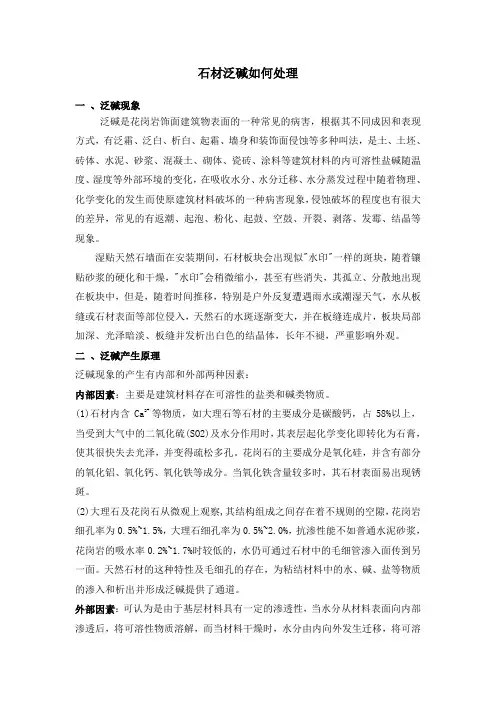
石材泛碱如何处理一、泛碱现象泛碱是花岗岩饰面建筑物表面的一种常见的病害,根据其不同成因和表现方式,有泛霜、泛白、析白、起霜、墙身和装饰面侵蚀等多种叫法,是土、土坯、砖体、水泥、砂浆、混凝土、砌体、瓷砖、涂料等建筑材料的内可溶性盐碱随温度、湿度等外部环境的变化,在吸收水分、水分迁移、水分蒸发过程中随着物理、化学变化的发生而使原建筑材料破坏的一种病害现象,侵蚀破坏的程度也有很大的差异,常见的有返潮、起泡、粉化、起鼓、空鼓、开裂、剥落、发霉、结晶等现象。
湿贴天然石墙面在安装期间,石材板块会出现似"水印"一样的斑块,随着镶贴砂浆的硬化和干燥,"水印"会稍微缩小,甚至有些消失,其孤立、分散地出现在板块中,但是,随着时间推移,特别是户外反复遭遇雨水或潮湿天气,水从板缝或石材表面等部位侵入,天然石的水斑逐渐变大,并在板缝连成片,板块局部加深、光泽暗淡、板缝并发析出白色的结晶体,长年不褪,严重影响外观。
二、泛碱产生原理泛碱现象的产生有内部和外部两种因素:内部因素:主要是建筑材料存在可溶性的盐类和碱类物质。
(1)石材内含Ca2+等物质,如大理石等石材的主要成分是碳酸钙,占58%以上,当受到大气中的二氧化硫(SO2)及水分作用时,其表层起化学变化即转化为石膏,使其很快失去光泽,并变得疏松多孔。
花岗石的主要成分是氧化硅,并含有部分的氧化铝、氧化钙、氧化铁等成分。
当氧化铁含量较多时,其石材表面易出现锈斑。
(2)大理石及花岗石从微观上观察,其结构组成之间存在着不规则的空隙,花岗岩细孔率为0.5%~1.5%,大理石细孔率为0.5%~2.0%,抗渗性能不如普通水泥砂浆,花岗岩的吸水率0.2%~1.7%时较低的,水仍可通过石材中的毛细管渗入面传到另一面。
天然石材的这种特性及毛细孔的存在,为粘结材料中的水、碱、盐等物质的渗入和析出并形成泛碱提供了通道。
外部因素:可认为是由于基层材料具有一定的渗透性,当水分从材料表面向内部渗透后,将可溶性物质溶解,而当材料干燥时,水分由内向外发生迁移,将可溶性物质携带到材料表面,随着表面水分蒸发,白色的可溶性物质留在表面,即产生泛碱现象。
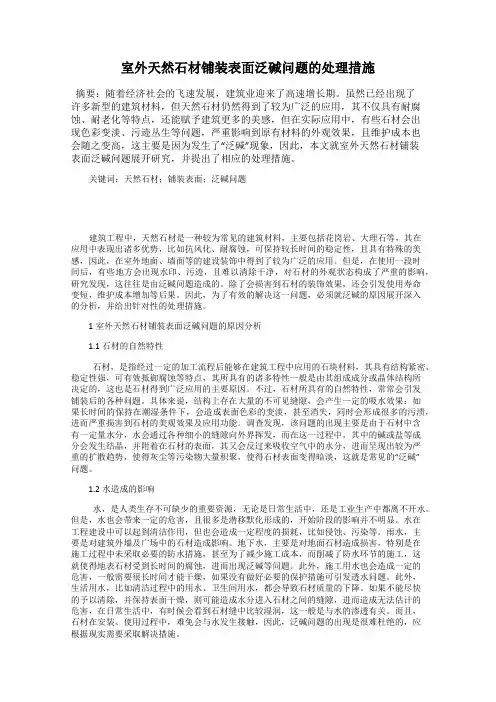
室外天然石材铺装表面泛碱问题的处理措施摘要:随着经济社会的飞速发展,建筑业迎来了高速增长期。
虽然已经出现了许多新型的建筑材料,但天然石材仍然得到了较为广泛的应用,其不仅具有耐腐蚀、耐老化等特点,还能赋予建筑更多的美感,但在实际应用中,有些石材会出现色彩变淡、污迹丛生等问题,严重影响到原有材料的外观效果,且维护成本也会随之变高,这主要是因为发生了“泛碱”现象,因此,本文就室外天然石材铺装表面泛碱问题展开研究,并提出了相应的处理措施。
关键词:天然石材;铺装表面;泛碱问题建筑工程中,天然石材是一种较为常见的建筑材料,主要包括花岗岩、大理石等,其在应用中表现出诸多优势,比如抗风化、耐腐蚀,可保持较长时间的稳定性,且具有特殊的美感,因此,在室外地面、墙面等的建设装饰中得到了较为广泛的应用。
但是,在使用一段时间后,有些地方会出现水印、污迹,且难以清除干净,对石材的外观状态构成了严重的影响,研究发现,这往往是由泛碱问题造成的。
除了会损害到石材的装饰效果,还会引发使用寿命变短,维护成本增加等后果。
因此,为了有效的解决这一问题,必须就泛碱的原因展开深入的分析,并给出针对性的处理措施。
1室外天然石材铺装表面泛碱问题的原因分析1.1石材的自然特性石材,是指经过一定的加工流程后能够在建筑工程中应用的石块材料,其具有结构紧密、稳定性强,可有效抵御腐蚀等特点,其所具有的诸多特性一般是由其组成成分或晶体结构所决定的,这也是石材得到广泛应用的主要原因。
不过,石材所具有的自然特性,常常会引发铺装后的各种问题。
具体来说,结构上存在大量的不可见缝隙,会产生一定的吸水效果;如果长时间的保持在潮湿条件下,会造成表面色彩的变淡,甚至消失,同时会形成很多的污渍,进而严重损害到石材的美观效果及应用功能。
调查发现,该问题的出现主要是由于石材中含有一定量水分,水会通过各种细小的缝隙向外界挥发,而在这一过程中,其中的碱或盐等成分会发生结晶,并附着在石材的表面,其又会反过来吸收空气中的水分,进而呈现出较为严重的扩散趋势,使得灰尘等污染物大量积聚,使得石材表面变得暗淡,这就是常见的“泛碱”问题。
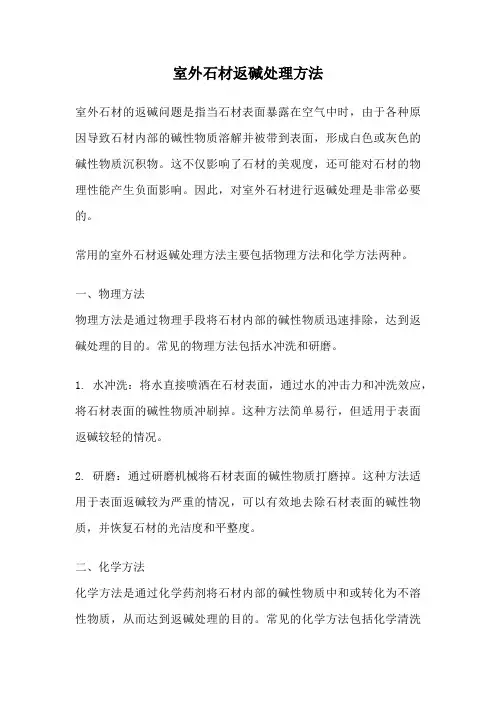
室外石材返碱处理方法室外石材的返碱问题是指当石材表面暴露在空气中时,由于各种原因导致石材内部的碱性物质溶解并被带到表面,形成白色或灰色的碱性物质沉积物。
这不仅影响了石材的美观度,还可能对石材的物理性能产生负面影响。
因此,对室外石材进行返碱处理是非常必要的。
常用的室外石材返碱处理方法主要包括物理方法和化学方法两种。
一、物理方法物理方法是通过物理手段将石材内部的碱性物质迅速排除,达到返碱处理的目的。
常见的物理方法包括水冲洗和研磨。
1. 水冲洗:将水直接喷洒在石材表面,通过水的冲击力和冲洗效应,将石材表面的碱性物质冲刷掉。
这种方法简单易行,但适用于表面返碱较轻的情况。
2. 研磨:通过研磨机械将石材表面的碱性物质打磨掉。
这种方法适用于表面返碱较为严重的情况,可以有效地去除石材表面的碱性物质,并恢复石材的光洁度和平整度。
二、化学方法化学方法是通过化学药剂将石材内部的碱性物质中和或转化为不溶性物质,从而达到返碱处理的目的。
常见的化学方法包括化学清洗和化学封固。
1. 化学清洗:使用专用的化学清洗剂,将其喷洒在石材表面,通过化学反应将石材内部的碱性物质中和或转化为不溶性物质,然后用清水冲洗干净。
这种方法适用于表面返碱较轻的情况,可以快速、有效地去除石材表面的碱性物质。
2. 化学封固:使用化学封固剂,将其涂刷在石材表面,通过与石材内部的碱性物质反应生成稳定的化合物,从而阻止碱性物质继续迁移到石材表面。
这种方法适用于表面返碱较为严重的情况,可以有效地防止碱性物质的再迁移。
需要注意的是,在进行室外石材返碱处理时,应根据具体情况选择合适的方法。
同时,还应注意以下几点:1. 在进行物理方法处理时,应根据石材的材质和处理效果进行适当的调整,以避免对石材表面造成二次损伤。
2. 在进行化学方法处理时,应选择符合环保要求的化学药剂和封固剂,以确保处理过程对环境无污染。
3. 在进行返碱处理前,应先对石材进行彻底的清洗,以去除表面的污垢和杂质,以提高处理效果。
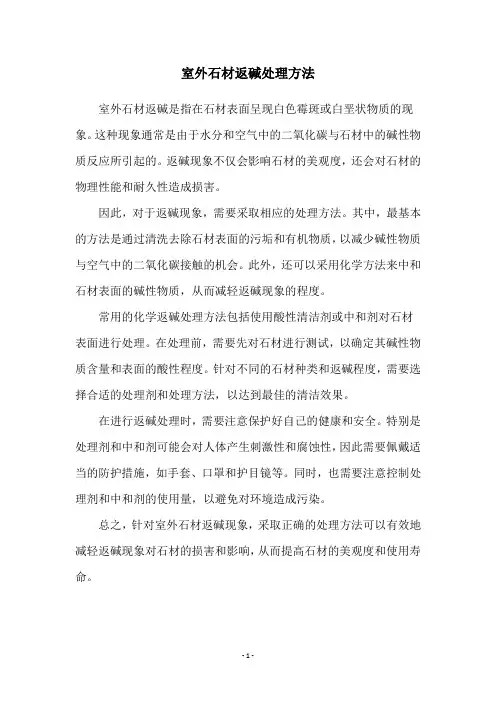
室外石材返碱处理方法
室外石材返碱是指在石材表面呈现白色霉斑或白垩状物质的现象。
这种现象通常是由于水分和空气中的二氧化碳与石材中的碱性物质反应所引起的。
返碱现象不仅会影响石材的美观度,还会对石材的物理性能和耐久性造成损害。
因此,对于返碱现象,需要采取相应的处理方法。
其中,最基本的方法是通过清洗去除石材表面的污垢和有机物质,以减少碱性物质与空气中的二氧化碳接触的机会。
此外,还可以采用化学方法来中和石材表面的碱性物质,从而减轻返碱现象的程度。
常用的化学返碱处理方法包括使用酸性清洁剂或中和剂对石材表面进行处理。
在处理前,需要先对石材进行测试,以确定其碱性物质含量和表面的酸性程度。
针对不同的石材种类和返碱程度,需要选择合适的处理剂和处理方法,以达到最佳的清洁效果。
在进行返碱处理时,需要注意保护好自己的健康和安全。
特别是处理剂和中和剂可能会对人体产生刺激性和腐蚀性,因此需要佩戴适当的防护措施,如手套、口罩和护目镜等。
同时,也需要注意控制处理剂和中和剂的使用量,以避免对环境造成污染。
总之,针对室外石材返碱现象,采取正确的处理方法可以有效地减轻返碱现象对石材的损害和影响,从而提高石材的美观度和使用寿命。
- 1 -。

外墙面砖泛碱原因及预防控制措施第一篇:外墙面砖泛碱原因及预防控制措施外墙面砖泛碱原因及预防控制措施一、泛碱原因1、为赶工期基层潮湿、勾缝过早,饰面砖镶贴完成后水分遇热蒸发,将基层水泥中的盐待至饰面砖表面,待饰面砖表面水分蒸发干燥后,盐留置在饰面砖表面。
2、饰面砖粘贴完成后在短时间内下雨或天气潮湿泛碱,雨水中的酸性溶液通过砖缝流入饰面砖立面与水泥发生反应生成的盐类,经水的动力将盐带到饰面砖的表面,带水干后,这些盐则以结晶的形式出现在饰面砖表面。
3、勾缝不密实,雨水通过砖缝渗入内部,与水泥发生反应,生成新的结晶体,经水的动力将盐带到饰面砖的表面,带水干后,这些盐则以结晶的形式出现在饰面砖表面。
4、外墙饰面砖镶贴完成后用酸性产品清洗,草酸、盐酸等酸性产品清洗外墙,与水泥发生反应,生成新的结晶体,带墙面表面干后墙面产生泛碱现象。
二、施工工艺处理基层→抹找平层→刷结合层→排砖、分格、弹线→粘贴面砖→勾缝→清理表面1、抹找平层应符合下列要求:1、在基层处理完毕后,进行挂线、贴灰饼、冲筋,其间距不应超过2m;2、抹找平层前应将基体表面润湿,并按设计要求在基体表面刷结合层;找平层应分层施工,严禁空鼓,每层厚度不应大于7mm,且应在前一层终凝后在抹后一层;找平层厚度不应大于20mm,若超过此值必须采取加固措施;3、找平层的表面应刮平搓毛,并在终结后浇水养护。
2、宜在找平层上刷结合层。
3、排砖、分格、弹线应符合下列要求:应按设计要求和施工样板进行排砖、并确定接缝宽度、分格、排砖宜使用整砖。
对必须使用非整砖的部位,非整砖宽度不宜小于整砖宽度的1/3。
弹出控制线,作出标记。
4、粘贴面砖应符合下列要求:1、在粘贴前应对面砖进行挑选,浸水2h以上并清洗干净,待表面晾干后方可粘贴。
2、粘贴面层时基层含水率宜为15﹪~25﹪。
3、面砖宜自上而下粘贴,粘结层厚度宜为4mm~8mm。
4、在粘结层初凝前或允许的时间内,可调整面砖的位置和接缝宽度,使之附线并敲实:在初凝后或超过允许的时间后,严禁震动或移动面砖。
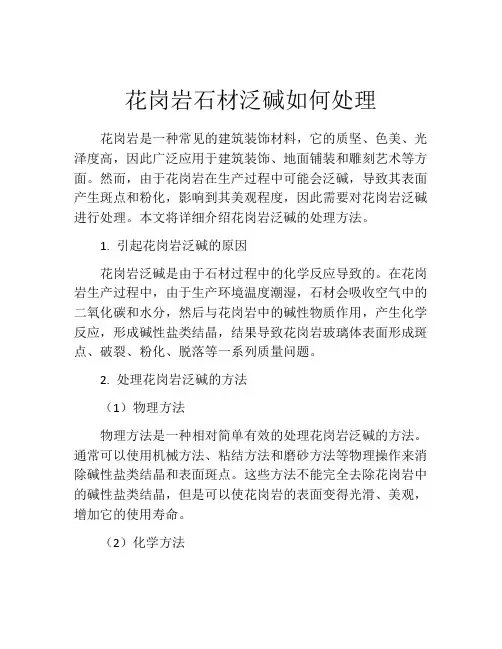
花岗岩石材泛碱如何处理花岗岩是一种常见的建筑装饰材料,它的质坚、色美、光泽度高,因此广泛应用于建筑装饰、地面铺装和雕刻艺术等方面。
然而,由于花岗岩在生产过程中可能会泛碱,导致其表面产生斑点和粉化,影响到其美观程度,因此需要对花岗岩泛碱进行处理。
本文将详细介绍花岗岩泛碱的处理方法。
1. 引起花岗岩泛碱的原因花岗岩泛碱是由于石材过程中的化学反应导致的。
在花岗岩生产过程中,由于生产环境温度潮湿,石材会吸收空气中的二氧化碳和水分,然后与花岗岩中的碱性物质作用,产生化学反应,形成碱性盐类结晶,结果导致花岗岩玻璃体表面形成斑点、破裂、粉化、脱落等一系列质量问题。
2. 处理花岗岩泛碱的方法(1)物理方法物理方法是一种相对简单有效的处理花岗岩泛碱的方法。
通常可以使用机械方法、粘结方法和磨砂方法等物理操作来消除碱性盐类结晶和表面斑点。
这些方法不能完全去除花岗岩中的碱性盐类结晶,但是可以使花岗岩的表面变得光滑、美观,增加它的使用寿命。
(2)化学方法化学方法是采取化学药品的方式去除花岗岩中的碱性盐类,这些化学药品可以中和碱性物质,并加速花岗岩石材表面的开裂,进而加快表面的碱性盐类溶解。
在进行化学处理时,我们需要选择对花岗岩具有化学惠肤,同时具有对环境友好的化学药品。
具体的化学处理方法如下:(a)酸性处理:使用弱酸或有机酸、卤酸等药品进行处理,在合适的环境下不停地轻刮表面,使表面酸性,对碱性盐类进行溶解。
(b)碱性处理:使用某些碱性的化学药品对碱性盐类进行腐蚀,同时增加花岗岩的表面孔隙率。
(c)溶解处理:通过采用化学溶液对碱性盐类进行溶解,在水溶液中加入复杂一些的配方,能有效溶解碱性盐类。
3. 预防花岗岩泛碱的方法预防花岗岩泛碱的方法主要包括:(1)在生产花岗岩的过程中,注意工艺、控制环境,保持干燥的生产环境和条件。
(2)在花岗岩石材表面喷洒阻碍剂,以改善表面的气孔性能,减少花岗岩吸收空气中的二氧化碳和水分。
(3)在生产前对花岗岩石材进行干燥处理。
景观石材返碱处理方法景观石材返碱是指在建筑装饰过程中,由于湿度和气候等原因,石材的表面会出现白色粉末状物质,并有碱性的现象。
这不仅会影响石材的外观美观,还可能对石材本身造成一定的损害。
因此,景观石材返碱处理方法非常重要。
一、返碱的原因景观石材出现返碱一般是由于以下几个原因所导致的:1.石材自身含有较高的碱性物质,如石英、长石等;2.石材未经过充分的水洗处理,残留的碱性物质没有完全清除;3.建筑工地附近有水泥、混凝土等碱性材料,碱性物质通过空气和水的介质渗入石材表面。
二、返碱的危害景观石材出现返碱会对石材本身和周围环境造成一定的危害:1.石材表面会出现白色粉末状物质,影响石材的外观美观;2.返碱的物质具有一定的腐蚀性,可能对石材进行损坏;3.返碱的物质可能对周围的植被和土壤造成一定的污染。
三、返碱的处处理方法景观石材返碱的处理方法很多,并且不同的方法对不同的石材也会有所不同。
下面介绍几种常用的返碱处理方法:1.溶解法:使用适量的中性溶液,如乙酸溶液、醋酸溶液等来溶解石材表面的碱性物质。
先用清水将石材表面冲洗干净,然后使用溶解剂进行刷洗,最后再次用清水冲洗干净。
2.酸洗法:使用稀盐酸或盐酸溶液来进行酸洗处理。
先将酸液稀释至适当浓度,然后用刷子将酸液均匀地涂抹在石材表面,等待一段时间后,再用清水冲洗干净。
3.磨削法:通过机械方法将石材表面的返碱物质进行磨削。
此方法适用于石材表面返碱较为严重的情况,可以完全去除石材表面的返碱物质。
但是需要注意的是,磨削过程中要避免对石材本身造成损害。
4.防渗透剂:使用防渗透剂来加强石材的防水防碱性能。
防渗透剂能够渗透到石材内部,并与碱性物质发生化学反应,从而降低石材返碱的可能性。
此方法适合于一些特殊石材,如花岗岩、大理石等。
除了以上几种常用的返碱处理方法外,还有一些其他的方法,如石材贴面、防潮垫、表面涂层等。
这些方法都是为了增强景观石材的抗碱性能,减轻或避免景观石材返碱的发生。
石材泛碱原因分析及防治措施一、石材饰面泛碱现象石材泛碱是湿贴石材常见的一种病变形式,常表现为石材表面出现均匀或不均匀的白色结晶颗粒,外墙若遇雨水冲淋,常表现为泪痕状流挂斑,石材表面光泽暗淡,影响外观效果。
二、成因分析1.天然石材内部存在许多肉眼看不到的毛细管,毛细管具有很强的虹吸能力,故天然石材抗渗透能力较差,水可以通过石材中的毛细管由浸入面传到另外一面,并由另一面表面挥发出去。
这样粘结材料中很多易溶于水的碱、盐等物质便随水一起经毛细管通道抵达另一表面,水分挥发后这些物质就即停留在石材表面。
2.当石材以湿贴方式施工时,其粘贴时所用水泥砂浆中的氢氧化钙等碱性物质,被大量的水分溶离出来渗透至石材表面,氢氧化钙再与空气中的二氧化碳反应,形成碳酸钙,当水分蒸发后,碳酸钙就呈结晶状物质停留在表面形成泛碱现象。
3。
根据水泥中碱性物质被溶解时的水分来源,泛碱可区分为一次泛碱和二次泛碱。
当拌和水泥砂浆时水灰比过高,过量的水分将氢氧化钙和碱性金属离子溶离出石材表面所形成的泛碱因其水源直接来自水泥的拌和水,因此称为“一次泛碱";石材安装完成在使用过程中当雨水等外来水在渗入石材底下的水泥砂浆,或地下水将氢氧化钙或碱性金属离子溶离出来渗透到石材表面,累计成白色半固体粉末所形成的泛碱因为是间接有外来水分溶解出铺贴所用水泥砂浆内的碱性物质所致,故称为“二次泛碱"。
4。
由此可见,粘结材料产生的含碱、盐等成分物质是渗入石材毛细孔产生泛碱的直接物质来源,而水是泛碱物质的溶剂和载体。
其发生原理见下图:石材泛碱发生原理示意图三、防治措施1.施工前管控要点(1)加强与设计单位的沟通协调工作,尽可能的在设计源头考虑如何消除泛碱的措施,条件允许水景立面尽可能使用干挂形式,池底尽可能使用专用万能支撑器平铺石材。
(2)水景中的结构均采用S6抗渗钢筋混凝土浇筑,结构面外设计加做防水层。
(3)水景中的面层石材尽量设计为大板,减少石材拼缝.(4)面层石材设计要求选用渗透型和成膜型防护剂六面防护处理。
花岗岩板材面返碱吐霜的防治1、原因花岗岩板材面返碱吐霜多生于外墙贴面,特别是当外墙无挑沿、挑廊等遮雨设施时更易发生,而室内很少见有返碱吐霜现象,显而易见,花岗岩板材贴面的返碱吐霜是由于存在渗漏的情况下,溶于水的碱溶液从花岗岩的板缝中溢流出来,从板材的细微毛孔中渗透出来,渗透出来的碱溶液与大气中二氧化碳接触又反应生成不溶于水的碳酸盐,整个过程与山洞中钟乳石的形成机理一样,且质地坚硬附着力强,很难清理干净。
怎样防治这一通病?返碱吐霜是因渗漏有机存在而发生的,那么围绕这一原因就可找出根治的办法:防渗漏和提高板材的抗渗性能能解决这一问题。
具体做法如下:2、挂贴(灌浆)工艺的工序流程按常规操作程序不变,但在粘贴之前必须对板材的反面作抗渗处理:先对板材反面进行清扫浮屑尘土,并用湿布抹干净,然后用107胶水沿泥浆涂刷二度,刷浆后阴干养护不少于7天,107胶水泥浆重量配合比一般为107胶:水泥=0.2:1,刷浆必须均匀且不得漏刷。
刷浆稠度以不咬刷帚为宜,不可过稀。
3、墙面顶部压顶的防渗漏一定要做好,一般设计无具体要求。
在实际施工中应杜绝使用水泥砂浆做压顶的做法,因为水泥砂浆压顶面与花岗岩贴面肯定会发生裂缝,从而产生渗漏。
正确的做法应该是用板材做压顶;与立面板材交角处做成45°交角式或挑边。
交角板缝应留设1.5—2mm,缝中5mm深度内的砂浆必须清理干净,最后成活前用密封胶注满。
4、板缝处理现行《建筑装饰工程施工及验收规范》(JGK73—91)第7、3、4条规定,镜面天然石板材的接缝宽度如设计无要求时为1mm,笔者认为,对于外墙挂贴(灌浆)石料板材在顶面无可靠罩雨设施情况下,接缝宽度应宜放宽1.5—2mm,以便于注填密封胶。
挂贴(灌浆)时随即将缝表面5mm深度内砂浆清理干净,在最后成活前用同一色的密封胶注填密实。
这样并不会影响整体美观。
笔者通过上述措施,在所经历的花岗岩板材外墙贴面工程中作过多次探索实施,基本上消除了返碱吐霜的通病。
这5点让你充分了解石材返(泛)碱的原因及解决方法石材作为一类高档装饰材料,被大家所钟爱。
可是越是喜爱,也越会因为它的某些缺陷而烦恼。
“返碱(泛碱)”是一直在石材护理人目前谈论最多的一个词眼,同样也是我们景观行业最受关注的问题。
站在风口浪尖,让我们一起来科普下这个备受大家关注的“返碱(泛碱)”到底是什么?1为什么石材会返碱?返碱与潮湿共生,石材返碱产生的三要素:水、水泥、石材的多孔性。
返碱产生的三要素①水泥石材的返碱,这些碱性物质并不是来自石材自身,而是来源于石材背后的水泥。
所以,返碱问题绝大多数发生在采用水泥粘接的石材表面。
而使用粘接剂、或者干挂等方式安装的石材,极少可能会发生返碱。
水泥的成分复杂,但其中的氢氧化钠、氢氧化钙等,是形成返碱的主要物质。
②石材的多孔性天然石材的材质特点,是其中密布着纳米级、微米级的微孔、微裂隙。
这些结构,是碱性物质、水等进出石材的通道。
③水、潮湿水,作为溶剂出现,是使返碱问题发生的最主要的“推手”,也可以说是“罪魁祸首”。
潮湿环境中的返碱2返碱的发生过程使用水泥作为粘接材料安装的石材,在长时间接触水、潮湿的前提下,水泥中的氢氧化钠、氢氧化钙等碱性物质,溶解到水中,并且沿着遍布石材的微孔、微裂隙结构,在毛细作用、和水的蒸腾作用力量带动下,被带往石材表面,析出。
当这些碱性物质析出石材表面后。
会随着时间的推移,发生两种变化:①变化一:凝结水将碱性物质带到石材表面后,迅速蒸发掉。
碱性物质就会凝结、沉淀在石材表面,形成粉末状的物质。
这是整个返碱过程的初级阶段。
这个阶段的返碱,是容易清洗掉的。
②变化二:变质和固化氢氧化钠、氢氧化钙是活泼的强碱性物质,非常容易和空气中的二氧化碳、硫化物等成分发生化学反应,生成碳酸钙、硫化物等新的化合物。
并且会逐渐的固化,变得难以清洗。
所以这种后续产生的物质,和初级阶段的返碱性质并不一样。
因此,我们将其称为“白华”。
3常见景观泛碱问题的原因分析(1)景墙内侧未做防水,雨水从灰缝中流到景墙正面形成泛碱流挂污染现象。
天然石材以其天然稳重.颜色壮丽及较好的抗风化稳固性.耐磨性.耐酸碱性等特色,被【1 】建筑师逐渐熟悉并普遍采取于建筑物的室内.外墙面装潢,极大地凸起了建筑的艺术后果.天然石材的装配施工有干挂法和湿贴法,个中湿贴法具有施工轻便,造价较底的长处,但也比较轻易产生一些质量通病,凸起的一点等于石材概况泛碱现象,产生泛碱后的墙面“水印”斑斑,去之无效,拆之亦难,极大地损坏了建筑装潢后果.广州近年建成的一些标记性公共建筑.广场建筑湿贴花岗岩有泛碱和析白流挂(白胡子)现象,有些甚至十分轻微,给这一建筑造成无可挽回的损掉和圆满.为此,剖析泛碱成因和作响应的预防措施具有重要意义.一、泛碱现象(Alkalization, Efflorescence)湿贴天然石墙面在装配时代,石材板块会消失似“水印”一样的斑块,跟着镶贴砂浆的硬化和湿润,“水印”会稍微缩小,甚至有些消掉,其孤立.疏散地出如今板块中,室内程度不轻微,影响外不雅不大.但是,跟着时光推移,特殊是外墙重复遭受雨水或潮湿气象,水从板缝.墙根等部位侵入,天然石的水斑逐渐变大,并在板缝连成片,板块局部加深.光泽阴暗.板缝并发析出白色的结晶体,长年不褪,轻微影响外不雅,此种现象称为泛碱现象.二.原因剖析Analysis1.天然石材结晶相对较粗,消失很多肉眼看不到的毛细管,花岗岩细孔率为0.5~1.5%,大理石细孔率为0.5~2.0%,其抗渗机能不如通俗水泥砂浆,花岗岩的吸水率0.2~1.7%是较低的,水仍可由经由过程石材中的毛细管浸入面传到别的一面.天然石材的这种特征及毛细孔的消失,为粘接资估中的水.碱.盐等物资的渗入和析出并形成泛碱供给了通道.1. Natural Stone crystal is relatively thick, there are m any naked eye can not see the capillary, granite pore rat e of 0.5 ~ 1.5%, marble pore rate of 0.5 ~2.0%, its impe rmeability is lower than ordinary cement mortar, granite water absorption is as low as 0.2 ~ 1.7%, water can still be through the stone from the surface of the capillary i mmersion reached the other side. This natural stone featu res and the presence of the pores for the bonding material in the water, alkali, salt, and the infiltration of sub stances such as precipitation provides the channel for th e forming of the Alkalization.2.粘结材料产生含碱.盐等成分物资.重要为镶贴砂浆析出Ca(OH)2(氢氧化钙)并追随过剩的拌合水,沿石材的毛细孔游离入侵板块,拌合水越多,移动到砂浆概况的Ca(O H)2就越多,水分蒸发后,Ca(OH)2就存积在板块里.其他,如在水泥中添加了含有钠Na+的外加剂,粘土砖泥土含有的Na+.Mg2+.K+.Ca2+.C1-.So42-.C032-等,遇水消融,会渗入渗出到石材毛细孔里,形成“白华”等现象.粘结材料产生的含碱.盐等成分物资是渗入石材毛细孔产生泛碱的直接物资起源.2. Bonded materials produced alkali, salt and other ingre dients material. Precipitation is mainly Xiangtie mortar Ca (OH) 2 (calcium hydroxide) and follow the excess mixin g water intrusion along the stone's pores free plate, mix ing more water, move to the mortar surface of Ca (OH) 2 m ore and more moisture evaporated, Ca (OH) 2 on the deposi t a c c u m u l a t e d o n t h e p l a t e i n s i d e. Others, such as adding cement admixtures containing sodiu m Na +, clay soil contains Na +, Mg2 +, K +, Ca2 +, C1-, So42-, C032-, etc., dissolved with water, will penetrate into the stone inside the pores to form a whitish surface a n d s o o n. Bonding materials are the source material for alkali, sal t and other ingredients to form alkalization.3.水的渗入.因为外墙接缝用水泥细砂砂浆勾缝,令防水后果差;地面水(或潮湿)沿墙体或砂浆层侵入石材板;装配时对石材洒水过多等原因,使水入侵石材板,并溶入Ca(O H)2和其他盐类物资进入石材毛细管形成泛碱.可见,水是泛碱物资的溶剂和载体.3. Water infiltration. As the outer wall joint is made with cement sa nd mortar resulting poor water proof; surface water (or wet) layer ofmortar along the wall, or invasive stone plate; installing the stone watering too much and other reasons, so that the water intrusion sto ne panels, and integration into the Ca (OH) 2 and other salts into th e stone by capillary formation of pan-alkali. This proves that water is the alkalization solvent and carrier.泛碱产生道理.Theory二、预防措施Precaution measures针对泛碱现象的成因,可以响应从割断泛碱的门路,削减Ca(OH)2.盐类等生成物及削减水的侵入三方面采纳措施,进行预防.(一)施工前预备1.设计上斟酌清除泛碱,尽可能设计成干挂情势;斟酌好构造的防水处理;选择吸水率及其他物理机能相符请求的石材板等.2.施工前要充分斟酌可能产生泛碱的各施工工艺环节,提前作好预防措施,如无掌控应先做样板.3.有关材料应先磨练后应用,不单请求外不雅.尺寸及格,并且其物理机能指标也要及格.A)p r e-c o n s t r u c t i o n p r e p a r a t i o n1. Use “d esign” to eliminate the alkalization, as far as possible designed to dry hanging form; considered good wa ter proofing treatment, choose water absorption and other stone panels with physical properties that meet the requ irements2.P r e p a r e m o c k-u p p a n e l.3. The material should be tested before using and the app earance, size, qualified, and their physical performance should also be qualified.(二)应用防碱背涂剂1.石板装配前在石材不和和正面背涂专用途理剂,该溶剂将渗入石材堵塞毛细管,使水.Ca(OH)2.盐等其他物资无法侵入,割断了泛碱现象的门路.无背涂处理,泛碱不成防止,经背涂处理的石材的粘接性不受影响.2.在石材板底涂刷树脂胶,再贴化纤丝网格布,形成抗拉防水层,但切不成忘却在正面作涂刷处理.(B) the use of anti-alkali- coating Paint1. Slate stone before installation in the back and side back Tu-specific treatment agent, the solvent would penetrate stone plug the capillary, so that the water, Ca (OH) 2, salt and other substances can not be penetrated, cut off the way the phenomenon of alkalization. If thereis no base coating processing, alkalizationis inevitable, the adhesion is not affected by applying the base coating.2. Apply resin glue on the base of the stone panel, and paste with fiber mesh to form water proof layer. Do not forget to apply the side with the same treatment.(三)削减Ca(OH)2.盐等物资生成1.镶贴用的水泥砂浆宜掺入削减剂,以削减Ca(OH)2析出,粘贴法砂浆稠度宜为6~8c m,灌浆法砂浆稠度宜为8~12cm.2.室外镶贴可采取水泥基商品胶粘剂(干混料),它具有优越的保水性,能大大减轻水泥凝聚泌水.室内镶贴可采取石材化学胶粘剂点粘.(C) reduction of Ca (OH) 2, salt and other substances generated1. Xiangtie used for mixing cement mortar should reduce the dose to reduce the Ca (OH) 2 precipitation and paste France mortar consistency might be desirable for 6 ~ 8cm, grouting mortar consistency might be desirable for 8 ~ 12cm.2. Cement-based products can be used outdoors Xiangtie adhesive (dry mixture), which has good water retention, can greatly reduce condensation Bleeding of cement. Stone can be used indoors Xiangtie chemical adhesive sticky point.(四)防止水的侵入1.功课前不成大量对石材和墙面淋水.2.地面墙根下应设置防潮层.卫生间.浴室等用水房间的外壁若有石材装潢,其内壁应需作防渗处理.3.外墙石材装潢面,为防止从板缝侵入,墙面板块必须离缝镶贴,缝宽不该小于5mm,应用石材专用硅硐耐候密封胶密封.4.室外施工搭设防雨蓬,处理好门窗框周边与外墙的接缝,防止雨水渗漏入墙.5.镶贴完成后,室外石材周全积喷涂有机硅防水剂或其他无色护面涂剂.(D) to prevent water intrusion1. Do not spray too much water on the stone and the wall.2. Damp proof membrane should be installed on the wall in the washroom. The wall should be treated with water proofing materials3. For outdoor stone walls, in order to prevent water intrusion from the joint, the wall plate to be away from the seam Xiangtie, Joint should not be less than 5mm, the use of stone special silicone sealant.4. Outdoor construction needs a temporary canopy to prevent rain’s effect during construction. Awning, window frames around the door handle and the exterior joints to prevent rainwater leaking into the wall.5. Spray the whole wall surface with water repellent.四.治理方法天然石材墙面一旦消失泛碱现象,因为可溶性碱(或盐)物资已沿毛细孔渗入渗出到石材里面(渗出石板概况的可以清除),很难清除,故应侧重预防,泛碱产生后只可作以下解救.1.尽快对墙体.板缝.板面等周全进行防水处理,防止水分持续入侵,使泛碱不再扩展.2.可应用市情上的石材泛碱清洗剂,该清洗剂是由非离子型的概况活性剂及溶剂等制成的无色半透明液体,对于部分天然石材概况泛碱的清洗有必定的后果.但是在应用前,必定要先作小样试块,以磨练后果和决议是否采取.总之,清除湿贴天然石墙面泛碱重在预防,只要探明其产生的根起源基础因,而在设计.材料.施工各环节中严厉把关,科学防治,就完整可防止泛碱现象的产生,使天然石材这种古老的建筑材料为现代建筑再放光荣.。
天然石材以其自然庄重、色彩绚丽及较好的抗风化稳定性、耐磨性、耐酸碱性等特点,被建筑师逐渐认识并广泛采用于建筑物的室内、外墙面装饰,极大地突出了建筑的艺术效果。
天然石材的安装施工有干挂法和湿贴法,其中湿贴法具有施工简便,造价较底的优点,但也比较容易产生一些质量通病,突出的一点即是石材表面泛碱现象,产生泛碱后的墙面“水印”斑斑,去之无效,拆之亦难,极大地破坏了建筑装饰效果。
广州近年建成的一些标志性公共建筑、广场建筑湿贴花岗岩有泛碱和析白流挂(白胡子)现象,有些甚至十分严重,给这一建筑造成无可挽回的损失和遗憾。
为此,分析泛碱成因和作相应的预防措施具有重要意义。
一、泛碱现象(Alkalization, Efflorescence)湿贴天然石墙面在安装期间,石材板块会出现似“水印”一样的斑块,随着镶贴砂浆的硬化和干燥,“水印”会稍微缩小,甚至有些消失,其孤立、分散地出现在板块中,室内程度不严重,影响外观不大。
但是,随着时间推移,特别是外墙反复遭遇雨水或潮湿天气,水从板缝、墙根等部位侵入,天然石的水斑逐渐变大,并在板缝连成片,板块局部加深、光泽暗淡、板缝并发析出白色的结晶体,长年不褪,严重影响外观,此种现象称为泛碱现象。
二、原因分析Analysis1.天然石材结晶相对较粗,存在许多肉眼看不到的毛细管,花岗岩细孔率为0.5~1.5%,大理石细孔率为0.5~2.0%,其抗渗性能不如普通水泥砂浆,花岗岩的吸水率0.2~1.7%是较低的,水仍可由通过石材中的毛细管浸入面传到另外一面。
天然石材的这种特性及毛细孔的存在,为粘接材料中的水、碱、盐等物质的渗入和析出并形成泛碱提供了通道。
1. Natural Stone crystal is relatively thick, there are man y naked eye can not see the capillary, granite pore rate of 0.5 ~ 1.5%, marble pore rate of 0.5 ~2.0%, its impermeabi lity is lower than ordinary cement mortar, granite water ab sorption is as low as 0.2 ~ 1.7%, water can still be throug h the stone from the surface of the capillary immersion rea ched the other side. This natural stone features and the pr esence of the pores for the bonding material in the water, alkali, salt, and the infiltration of substances such as pr ecipitation provides the channel for the forming of the Alk alization.2.粘结材料产生含碱、盐等成分物质。
主要为镶贴砂浆析出Ca(OH)2(氢氧化钙)并跟随多余的拌合水,沿石材的毛细孔游离入侵板块,拌合水越多,移动到砂浆表面的Ca (OH)2就越多,水分蒸发后,Ca(OH)2就存积在板块里。
其他,如在水泥中添加了含有钠Na+的外加剂,粘土砖土壤含有的Na+、Mg2+、K+、Ca2+、C1-、So42-、C032-等,遇水溶解,会渗透到石材毛细孔里,形成“白华”等现象。
粘结材料产生的含碱、盐等成分物质是渗入石材毛细孔产生泛碱的直接物质来源。
2. Bonded materials produced alkali, salt and other ingredi ents material. Precipitation is mainly Xiangtie mortar Ca (OH) 2 (calcium hydroxide) and follow the excess mixing wat er intrusion along the stone's pores free plate, mixing mor e water, move to the mortar surface of Ca (OH) 2 more and m ore moisture evaporated, Ca (OH) 2 on the deposit accumulat ed on the plate inside.Others, such as adding cement admixtures containing sodium Na +, clay soil contains Na +, Mg2 +, K +, Ca2 +, C1-, So42-, C032-, etc., dissolved with water, will penetrate into the stone inside the pores to form a whitish surface and so on.Bonding materials are the source material for alkali, salt and other ingredients to form alkalization.3.水的渗入。
由于外墙接缝用水泥细砂砂浆勾缝,令防水效果差;地面水(或潮湿)沿墙体或砂浆层侵入石材板;安装时对石材洒水过多等原因,使水入侵石材板,并溶入Ca (OH)2和其他盐类物质进入石材毛细管形成泛碱。
可见,水是泛碱物质的溶剂和载体。
3. Water infiltration. As the outer wall joint is made with cement sa nd mortar resulting poor water proof; surface water (or wet) layer of mortar along the wall, or invasive stone plate; installing the stone watering too much and other reasons, so that the water intrusion sto ne panels, and integration into the Ca (OH) 2 and other salts into th e stone by capillary formation of pan-alkali. This proves that water is the alkalization solvent and carrier.泛碱发生原理。
Theory二、预防措施Precaution measures针对泛碱现象的成因,可以相应从切断泛碱的途径,减少Ca(OH)2、盐类等生成物及减少水的侵入三方面采取措施,进行预防。
(一)施工前准备1.设计上考虑消除泛碱,尽可能设计成干挂形式;考虑好结构的防水处理;选择吸水率及其他物理性能符合要求的石材板等。
2.施工前要充分考虑可能发生泛碱的各施工工艺环节,提前作好预防措施,如无把握应先做样板。
3.有关材料应先检验后使用,不但要求外观、尺寸合格,而且其物理性能指标也要合格。
A) pre-construction preparation1. Use “d esign” to eliminate the alkalization, as far as po ssible designed to dry hanging form; considered good water proofing treatment, choose water absorption and other ston e panels with physical properties that meet the requirement s2. Prepare mock-up panel.3. The material should be tested before using and the appea rance, size, qualified, and their physical performance sho uld also be qualified.(二)使用防碱背涂剂1.石板安装前在石材背面和侧面背涂专用处理剂,该溶剂将渗入石材堵塞毛细管,使水、Ca(OH)2、盐等其他物质无法侵入,切断了泛碱现象的途径。
无背涂处理,泛碱不可避免,经背涂处理的石材的粘接性不受影响。
2.在石材板底涂刷树脂胶,再贴化纤丝网格布,形成抗拉防水层,但切不可忘记在侧面作涂刷处理。
(B) the use of anti-alkali- coating Paint1. Slate stone before installation in the back and side back Tu-specific treatment agent, the solvent would penetrate stone plug the capillary, so that the water, Ca (OH) 2, salt and other substances can not be penetrated, cut off the way the phenomenon of alkalization. If there is no base coating processing, alkalization is inevitable, the adhesion is not affected by applying the base coating.2. Apply resin glue on the base of the stone panel, and paste with fiber mesh to form water proof layer. Do not forget to apply the side with the same treatment.(三)减少Ca(OH)2、盐等物质生成1.镶贴用的水泥砂浆宜掺入减少剂,以减少Ca(OH)2析出,粘贴法砂浆稠度宜为6~8 cm,灌浆法砂浆稠度宜为8~12cm。
2.室外镶贴可采用水泥基商品胶粘剂(干混料),它具有良好的保水性,能大大减轻水泥凝结泌水。
室内镶贴可采用石材化学胶粘剂点粘。